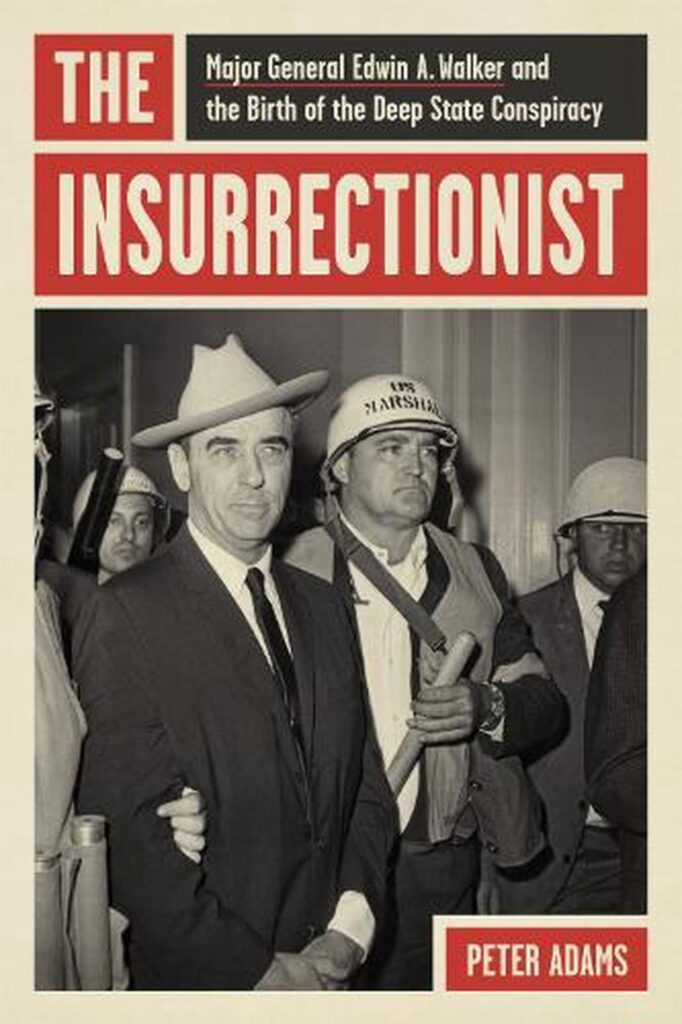The “Insurrectionist” Smear
Is conservativism in America tainted by a long-deceased former general few people have ever heard of? It turns out that liberals regard anyone who disagrees with them as “extremists” and, now, “insurrectionists.”
This essay originally appeared in Law & Liberty on November 21, 2023 (here). Thanks to Power Line and Instapundit (here)!
In response to an American history trivia question “Who was Gen. Edwin A. Walker?”, a well-informed Boomer might be able to answer that he was a controversial figure who was Lee Harvey Oswald’s original assassination target in 1963. A legally-astute respondent could possibly go further and identify Walker as the plaintiff in a libel case whose $500,000 verdict against Associated Press was overturned by the U.S. Supreme Court in 1967 when the “actual malice” standard established in New York Times v. Sullivan (1964) was extended to include “public figures” who are not actual “public officials.” Otherwise, Walker, an eccentric character who served with distinction as an officer in the Army in WWII and the Korean War, who espoused increasingly-bizarre views following his retirement, and who died in 1993, has largely faded from memory. Indeed, journalists who even noted Walker’s passing 30 years ago acknowledged that he died “in obscurity.”

Why then, one is entitled to ask, would LSU Press now publish what is described as “the first comprehensive biography” of Walker, titled The Insurrectionist? Author Peter Adams explains that his motivation was not so much based on Walker’s influence or accomplishments in his time—conceding that Walker was “odd” and that his notoriety in the 1960s was “brief”—but as an ominous portent of current events: QAnon and other “deep state” conspiracy theories, the January 6 “insurrection,” and the “extreme Right” in general. Adams views Walker’s story as “a cautionary tale for our times,” but is it?
In a word, No. Adams is apparently preoccupied with the threat posed by conservatives, whom he repetitively (and negatively) labels throughout the book as “militant Right,” “ultra Right,” “extreme Right,” “radical Right,” “fundamentalist Right,” “Far Right,” “New Right,” “Christian Right,” “paranoid Right,” “populist Right,” “evangelical Right,” etc. Yet Adams fails to make the case that Walker’s quixotic and idiosyncratic beliefs were pivotal in his day or that they have any meaningful connection to modern political movements.
While I hold no brief for Walker, an erratic racist and anti-Semite prone to reckless charges of Communist conspiracies and careless associations with repugnant bigots, he played an inconsequential role in 20th century history and was not a model for or typical representative of the conservative movement in America. Mainstream conservatives at the time, such as William F. Buckley, properly viewed Walker as an unstable outlier. Walker was not a major figure in American politics and certainly was not a harbinger of Donald Trump (with whom Walker has nothing in common), as Adams risibly suggests. Adam’s bias against conservatives is palpable and his narrative is predictable and heavy-handed. Analyzing the events and personalities of the post-WWII era requires both balance and nuance, wholly absent here.
The 1950s were complicated and deeply-unsettling times. The Cold War era (Iron Curtain; Soviet espionage leading to the USSR’s detonation of a nuclear device; Korean War fought under UN command, and ending in a truce; Sputnik; Communist aggression around the globe; Cuban missile crisis), Warren Court judicial activism, and court-ordered desegregation understandably provoked some strong—and even outlandish–reactions in certain quarters of American society. These included John Birch Society founder Robert Welch’s now-famous charge that President Dwight Eisenhower was possibly a “dedicated conscious agent of the Communist conspiracy.” Other groups (Minutemen, Christian Crusade, Liberty Lobby), were even more virulent, but these voices were always on the outer-fringe of the American Right.
Walker, along with many other Americans at the time, traveled in these circles, but he was never anything more than a follower and a mouthpiece. Ironically, Adams repeatedly denigrates Walker’s ability to communicate effectively, terming him “an abysmal public speaker,” “inarticulate,” “a poor speaker,” “incoherent,” “tongue-tied,” “rambling,” and the like. Yet we are to believe that he was a charismatic leader and a threat to the republic?
Moreover, in light of Adams’ own recitation of the facts, it is ludicrous to depict Walker as a “hero” of the American Right—then or now–or as “America’s first modern insurrectionist.” Walker, a West Point graduate, was a decorated war hero who resigned from what had been a distinguished military career (forfeiting his pension in the process) in 1961, after successfully commanding federal troops to oversee the integration of Central High School in Little Rock, Arkansas, over the objection of Gov. Orval Faubus. As a soldier, Walker followed his orders. This made Walker unpopular among some southerners and newspapers sympathetic to segregation. Walker’s conduct in uniform was hardly that of a deranged fanatic.
Chafing at what he perceived to be a “soft-on-Communism” leadership in the military, after resigning from the Army Walker declared himself a candidate for Governor of Texas in 1962. Free of military protocols, Walker was able to air his conspiratorial views and make rash accusations. As a political candidate, however, Walker was an utter failure. He came in last in a six-person field, drawing less than ten percent of the vote in the Democratic primary. Adams concedes that this dashed any hope Walker held for elected office. But we are to believe that Walker was a significant political threat?
Conservative politicians viewed Walker as a loose cannon and kept him at a distance. Sen. Barry Goldwater refused to share a stage with Walker in 1962 and later, during Goldwater’s presidential campaign, Goldwater denied Walker a seat on the Texas delegation to the 1964 Republican convention. Walker was never a national figure; his six-week, 27-city road show with evangelist Billy James Hargis in 1963, dubbed “Operation Midnight Ride,” drew a total attendance of only 40,000—fewer than a single Taylor Swift concert—and was a financial bust. Walker was the political equivalent of a circus sideshow performer or a cartoon character.
Walker’s vocal criticism of Communism was enough, however, to attract the attention of fellow Dallas resident Oswald, who used his mail order Carcano carbine rifle to shoot at Walker in his home (barely missing) seven months before Oswald—a dedicated Communist—assassinated President Kennedy with the same rifle in November 1963. Despite Walker being a target himself, Adams absurdly implies that Walker was to blame for the “climate of hate” that supposedly inspired Oswald! Oswald was no right-winger. He had moved from the U.S. to Russia in 1959 seeking to renounce his American citizenship to become a citizen of the Soviet Union. He met and married a Russian woman before moving back to the U.S. in 1962. Even after Oswald and his wife returned to the U.S., he made efforts to visit Cuba. Oswald was a committed Marxist and dangerous menace without regard to domestic politics in Texas or Dallas.
Contrary to Adams’ contention, Walker never achieved “hero” status on the Right. His popularity, such as it was, plummeted in the 1960s as the John Birch Society fell out of favor. Adams admits that “Walker faded into obscurity,” became a “largely forgotten recluse,” and was regarded as “an eccentric curiosity.” As it turns out, Walker—a lifelong bachelor–was also a “deeply closeted gay man” who was arrested for public lewdness in 1976. This was the final nail in Walker’s political coffin. He was a pariah, not a hero. Unlike Sen. Joseph McCarthy, whose infamy only grew following his death in 1957, Walker simply vanished from history.
What about his status as an “insurrectionist”? Adams devotes an entire chapter, entitled “Insurrection at Ole Miss,” to Walker’s involvement, as a civilian, in protests to the (widely-unpopular, in the Deep South) judicially-mandated integration of the University of Mississippi–by way of the enrollment of James Meredith–in the fall of 1962. Adams notes that Walker was one of about 200 people arrested for their role in the extended protests, which ultimately turned violent. Not only was Walker ordered arrested for “conspiracy to incite an insurrection,” he was sent for psychiatric evaluation—initially without bail–to a federal facility in Missouri. Walker’s confinement outraged both the ACLU and libertarian psychiatrist Thomas Szasz, neither of whom were affiliated with the fringe groups Adams myopically focuses on.
When finally evaluated, Walker was found to be mentally competent. He never stood trial for the charges because a grand jury in Oxford, Mississippi refused to indict him. The charges against him were dismissed in January 1963. Thus, Walker was not even formally charged with a crime, let alone convicted. In 1964, Walker sued the Associated Press for libel in Fort Worth for misreporting his actions in the Ole Miss protests, and he won, only to see the half-million-dollar jury verdict thrown out by the Supreme Court. Walker was a crank and a dissident, but it is mendacious to label him an insurrectionist. John Brown was an insurrectionist; Walker was a deluded—but essentially harmless—zealot.
Adams is similarly sloppy in his use of pejorative labels elsewhere. He calls Father Charles Coughlin, the so-called “Radio Priest” who reached a mass audience during the Depression, a “radical Right” figure with a “pro-fascist” message. While Coughlin was undeniably an anti-Semite, he was also a socialist who complained that FDR was too friendly to bankers. Coughlin advocated the nationalization of major industries and railroads. His newspaper was called Social Justice. It is misleading in the extreme to suggest that Coughlin was a man of the Right. He criticized FDR from the Left (as did Louisiana Gov. Huey Long). Likewise, Adams shows his bias when he insinuates that Alger Hiss, one of the key organizers of the UN, was not a Soviet spy, ignoring the overwhelming evidence (from the declassified Venona files) of Hiss’ guilt.
The most tendentious chapter of The Insurrectionist is the epilogue, in which Adams attempts to “connect the dots” between Walker’s peculiar beliefs from 60 years ago and current events; “we are again in a strange time,” he intones. How so? The book’s subtitle is “Major General Edwin A. Walker and the Birth of the Deep State Conspiracy.” Adams implicitly argues that any concerns about government overreach amount to “paranoid thinking” similar to Walker’s nutty reveries. Classical liberals oppose excessive government power because they value freedom, not because of half-baked “conspiracy theories.” LSU Press advertises the book with this overheated rhetoric: “Walker’s deep state conspiracy theory has echoed through American political culture into the age of QAnon, finding a new home among today’s far-right extremists.”
In other words, Adams implies that all conservatives, even those who have never heard of the disgraced Gen. Edwin Walker, are somehow influenced by him. This goes beyond guilt-by-association and is simply preposterous. Alternatively, the broad sweep of The Insurrectionist’s tar-brush could be read to suggest that modern conservatives opposed to the federal Leviathan are as nutty as Walker was—simply because of their political philosophy.
Adams draws no distinctions among center-right beliefs or figures, intimating, for example, that Covid-skepticism is comparable to Alex Jones’ unhinged rants; opposition to gun control is akin to QAnon disinformation; and that even mainstream groups such as the Heritage Foundation engage in extremism by criticizing the radical environmentalist agenda. Judging from the unremittingly shrill tone of The Insurrectionist, I suspect that Adams regards any political beliefs to the right of current Democratic Party dogma to be “extremist,” indicative of “the radical fringe,” or even incipient fascism.
The Insurrectionist is a tedious and disjointed clip job based primarily on secondary sources, containing little more pertinent factual information than Walker’s Wikipedia entry. I would not recommend this book to a reader seeking an objective overview of the tumultuous events of the 1950s and 1960s. LSU Press has not distinguished itself by publishing this hyperbolic tract.
































